Table of contents
- Premiere Yamaha YZF-R1 + videos MotoGP technology in series production
- The screamer
- Performance development, handling
- Chassis and brakes
- Conclusion
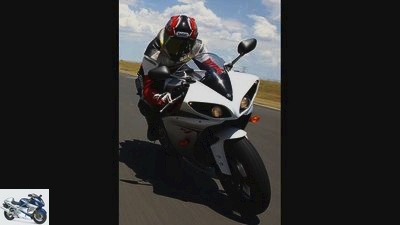
Yamaha
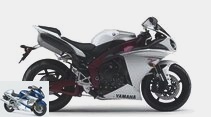
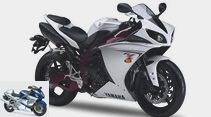
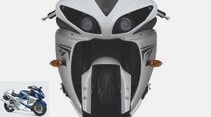
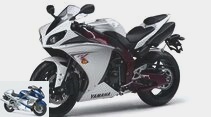
33 pictures
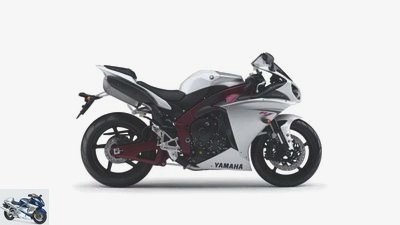
Yamaha
1/33
First of all, we will take a look at the device: The variant with a red painted frame looks particularly elegant.
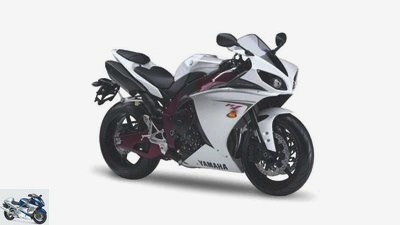
Yamaha
2/33
In terms of design, it has moved a long way away from its predecessors with the short rear without giving up the typical Yamaha design language.
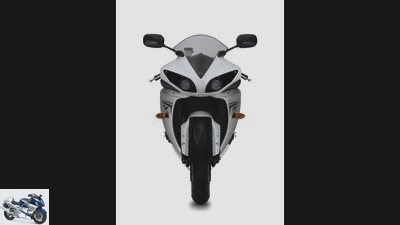
Yamaha
3/33
Two projection headlights are sufficient for the 2009 R1; the familiar four-eye face has had its day. A movable cover, no longer two filaments, controls the switching between high and low beam.
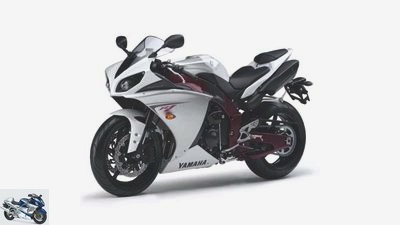
Yamaha
4/33
The new, compact design is intended to underline the idea of mass centralization.
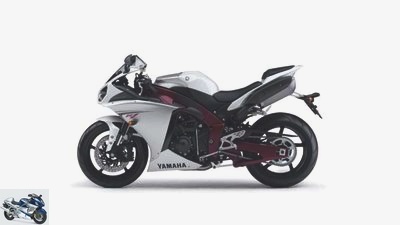
Yamaha
5/33
The jagged side paneling understates: The promised 182 PS means that you can expect far more driving dynamics than the sharp, dark edge next to the engine suggests.
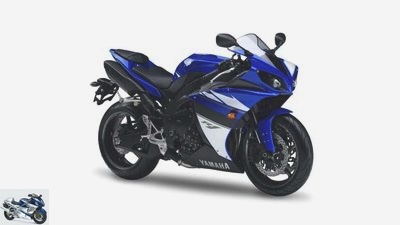
Yamaha
6/33
In addition to white, the 2009 Yamaha YZF-R1 is also available in blue.
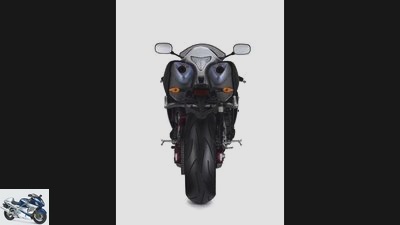
Yamaha
7/33
The two triangular underseat silencers naturally have all color variants in common. And they will probably be quickly replaced with even more elegant accessories for all color variants.
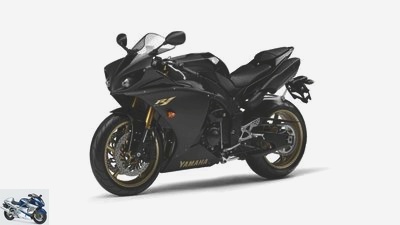
Yamaha
8/33
In black with golden painted wheels, it also looks chic; reminds a bit of the SP variant of a previous model.
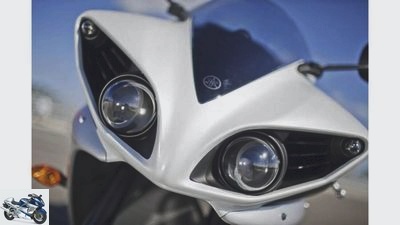
Yamaha
9/33
The inlets for the Ram Air system have been moved next to the headlights.
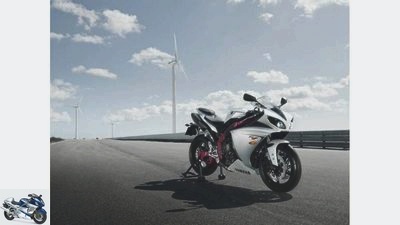
Yamaha
10/33
It’s high time the device came out on the track!

Yamaha
11/33
In such situations, the standard steering damper calms the front and the driver’s nerves.
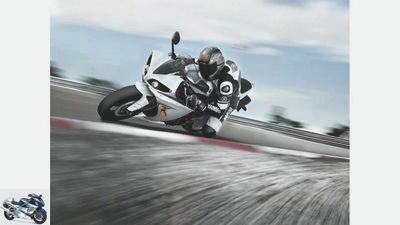
Yamaha
12/33
Yamaha promises a performance characteristic for its new R1 with which the driver can accelerate out of the curve precisely at the tire grip limit, even in an inclined position.
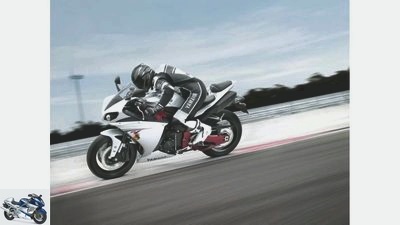
Yamaha
13/33
Another promise from the manufacturer: Various components contribute to the balance between strength and flexibility, i.e. between stability and feedback.
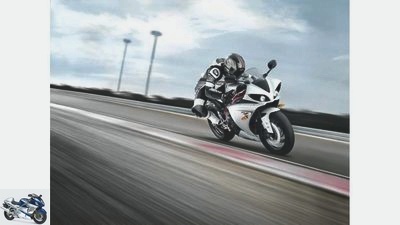
Yamaha
14/33
Nevertheless, of course, nobody should think that handling 182 hp and 115 Newton meters safely is suddenly child’s play.
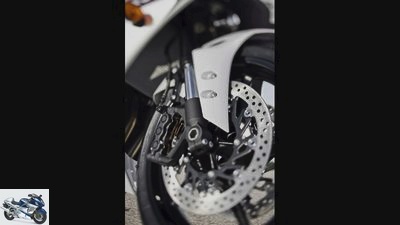
Yamaha
15/33
On the front wheel, two six-piston fixed callipers grip the two 310 millimeter discs. The discs themselves have become lighter, which reduces the mass moment of inertia of the front wheel and improves handling.
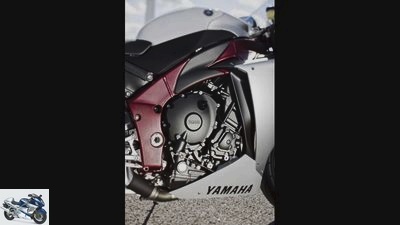
Yamaha
16/33
The engine is 12 millimeters further forward and 9 degrees more upright than in the previous R1; the cylinders are tilted forward 31 degrees.
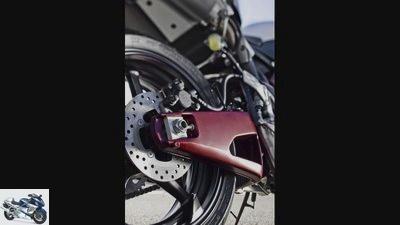
Yamaha
17/33
The R1’s recipe for success: long swing arm despite short wheelbase. The rear frame is made of titanium.
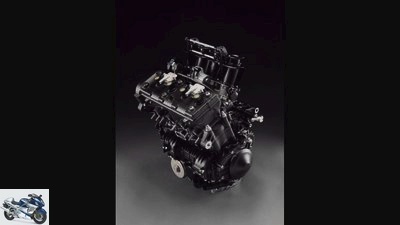
Yamaha
18/33
This is what the powerhouse looks like “solo” the end. YCC-I, the variable-length intake funnels, are easy to recognize. Not the unusual big bang crankshaft.
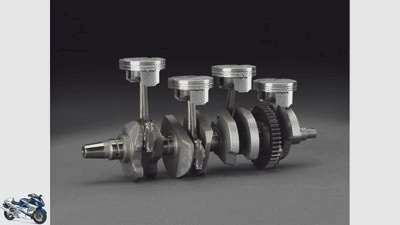
Yamaha
19/33
Clearly visible: All four pistons are at a different point on their career because the crank pins on which the four connecting rods engage are each offset by 90 degrees.

Yamaha
20/33
Ultralight forged pistons with minimal piston skirt (you read elsewhere “Piston t-shirt”) reduce the oscillating masses. The carbon-hardened connecting rods with broken feet are both light and strong.
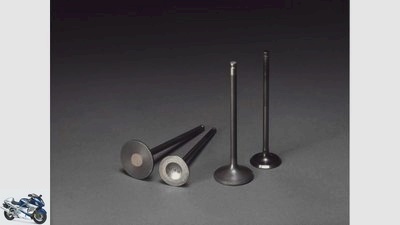
Yamaha
21/33
Nominal speed: 12500 / min. The four valves per cylinder have to work hard.
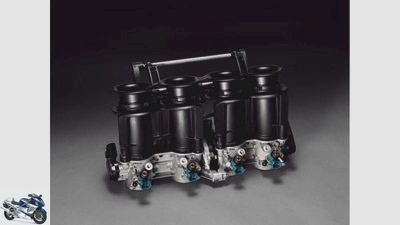
Yamaha
22/33
The famous YCC-I, (“Yamaha Chip Controlled Intake”, So Yamaha’s electronically controlled inlet), here in wait at low and medium speeds with long funnels.
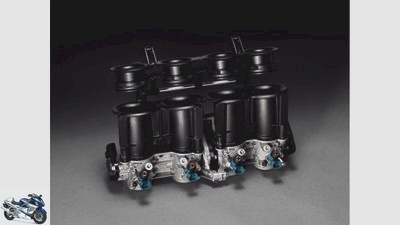
Yamaha
23/33
At higher speeds, a servomotor lifts a little off the funnels, which improves the oscillation of the gas column, thus improving the ability to turn and ultimately the power output.

Yamaha
24/33
There is no more mundane throttle cable to the throttle valve, but a map-controlled servomotor works here as well. Ingestion almost impossible. The system is called YCC-T, Yamaha Chip Controlled Throttle. Yamaha’s electronically controlled inlet.
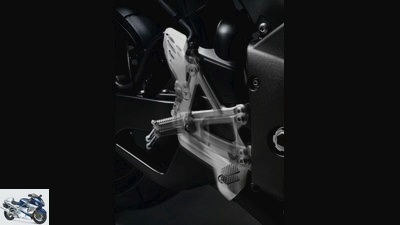
Yamaha
25/33
Nothing is fixed – not even the position of the footrests, brake and shift levers.
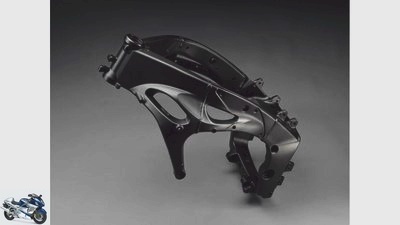
Yamaha
26/33
Everything new: about the only thing that the Deltabox frame has in common with its predecessor are the openings for the Ram-Air supply lines. The rest is completely new and of course optimized in every respect.
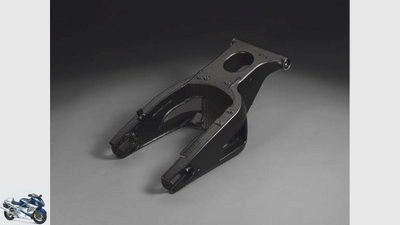
Yamaha
27/33
Swing when you’re winning. Its pivot point is close to the drive pinion, which reduces the influence of the chain hoist on the rear suspension. It goes without saying that it is as light as it can be given its stability.
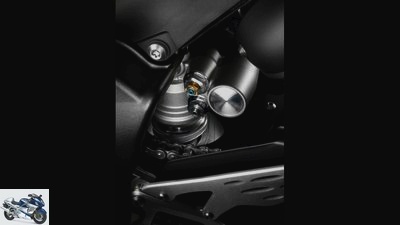
Yamaha
28/33
Hunting high and low: The adjustment of the compression damping comes in two flavors – for fast and slow compression movements. The spring base can be varied by hydraulics.
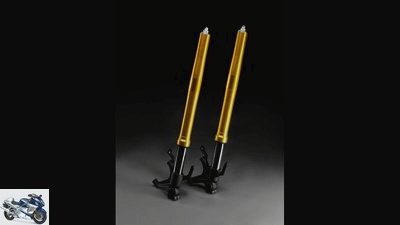
Yamaha
29/33
Do you know the East Frisian helicopter? 2 people, one honking, one screwing. Something like this Japanese fork: 2 spars, one rebound damped, one compression damped.

Yamaha
30/33
Greedy object? Object of desire? Probably both, you really want to climb on it.
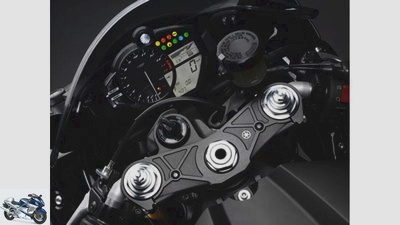
Yamaha
31/33
The multifunction cockpit and, thankfully, the analog tachometer are fully equipped for sports use – and even a little more.
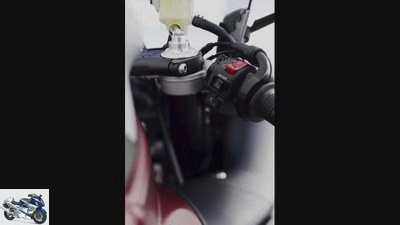
Yamaha
32/33
So what is the miserly: flip the kill switch, yodel the starter, and off you go!

Yamaha
33/33
See you at the Yamaha dealer. Or right on the ring!
motorcycles
Premiere Yamaha YZF-R1 + videos
Premiere Yamaha YZF-R1 + videos
MotoGP technology in series production
Content of
The PR strategists give the slogan for the Yamaha YZF-R1, built in 2009, model code RN22 “Born from MotoGP” the end. We tried out what’s behind it.
Uwe Seitz
03/20/2009
The screamer
Since the Yamaha YZF-R1 entered the 1000 cc Superbike class 11 years ago, a lot has happened to it: in 2002 the switch to injection, in 2007 the characteristic five-valve technology disappeared. Since then there have been variable intake funnel lengths (YCC-I) and an electronic throttle grip (YCC-T).
The reference to MotoGP for the 2009 R1 is not that exaggerated, because its engine borrowed directly from Valentino Rossi’s work tool: a crankshaft with a 90 degree crank pin offset.
The excitement begins with the audio sample on the pit wall: The Yamaha YZF-R1 roars much more deeply than its competitors from Japan and lets expectations skyrocket.
Performance development, handling
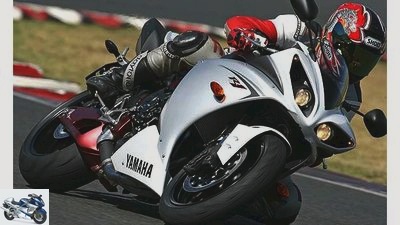
Yamaha
The Yamaha YZF-R1 spins around the Eastern Creek race track in a clean, controllable manner.
What the rider experiences in the saddle inspires: the engineers do the same novel firing order and other steps succeeded in completely turning the performance curve of the Yamaha YZF-R1 inside out and making it much more harmonious: The engine pushes hard from just above idle and develops its power very linearly over the entire speed range.
Three maps has the motor control ready: The standard mode is the all-rounder that provides power anytime, anywhere. Mode A reacts a little more sharply, but cuts a few horsepower at the top. In mode B, the throttle starts noticeably more gently.
In any case, the engine depends very directly on the gas, which makes it seem playfully easy to control the R1. When you apply the gas at the apex of the curve, nothing jerks and no delay plays with your nerves. The driver literally has it in hand and does not have to be of any kind Engine characteristics surprise.
The new one is going well 182 hp unit; the mechanical noises from the centerpiece are fun. After every shift with the inconspicuous transmission, the R1 roars a song that is clearly reminiscent of MotoGP transmissions.
The Yamaha YZF-R1 has gained further qualities. The 2009 model received Chassis and running gear a comprehensive rejuvenation treatment. The Deltabox frame is practically new in shape and size. In addition, the 18-liter tank sank behind the engine almost down to the swing arm bearing. The engine itself slid down 12 millimeters, and the lever-operated shock absorber was repositioned.
This is where the main emphasis the Yamaha YZF-R1 deeper, which makes it more agile. It is child’s play and precise to move from one curve to the next. The compact, yet relatively comfortable sitting posture promoted the impression of sitting on a 600 and not a 1000.
Chassis and brakes
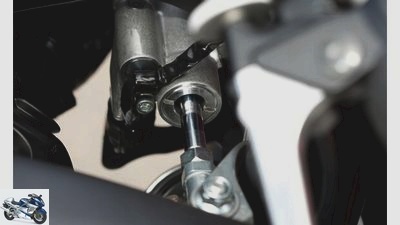
Yamaha
The electronically controlled steering damper of the Yamaha YZF-R1 could work a little tighter.
Riding the Yamaha YZF-R1 is very forward-looking, that Feel for the front wheel therefore clearly. The compression and rebound damping of the 43 mm fork are divided between the fork legs.
the fork responds very sensitively, which is particularly clear in the super-fast fourth-gear left after start / finish: Despite fine, nasty bumps in full incline, the motorcycle remains on course.
Even when braking hard, the Yamaha YZF-R1 remains stable, which is why the Slipper clutch does its part. The drive train jerks slightly in front of the tight first-gear bends, but even relentless engagement does not provoke any pounding.
The feeling for the rear of the vehicle is excellent. The smallest slides are clearly announced and are very easy to control. That Shock absorber with separate high and low-speed adjustment of the compression damping, the hydraulically variable spring base does a good job.
The new lever mechanism of the Brake pump should optimize the dosability of the front stoppers. In fact, it works very well, the first pressure enables gentle braking. One-finger brakes in particular can decelerate well into the curve in a finely dosed manner without having to use more fingers. With increased pressure, the brake then grabs very snappy.
The only criticism of the Yamaha YZF-R1: The electronically controlled Steering damper one or the other time he braces himself a little too laxly against the light front wheel.
Conclusion
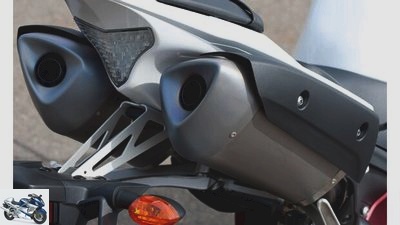
Yamaha
The 2009 Yamaha YZR-R1 is very compact, only the exhaust blows out far.
Conclusion: The 2009 Yamaha YZF-R1 is probably the biggest hit from this manufacturer since the 1-liter superbikes were launched. The huge technical effort will certainly pay off when selling. In terms of performance and emotion, he already has that.
| Technical specifications |
Related articles
-
Yamaha 37 pictures Yamaha 1/37 First look at the device from all sides… Yamaha 2/37 Yamaha 3/37 Yamaha 4/37 Yamaha 5/37 Yamaha 6/37 Yamaha 7/37 What is…
-
Yamaha motorcycles Super athlete Yamaha YZF-R1 Yamaha YZF-R1 A new kind of V4 experience Japan’s four-cylinder technology seemed set in stone. But now…
-
Honda Fireblade, Kawasaki Ninja ZX-10R, Suzuki GSX-R 1000, Yamaha YZF-R1
fact 28 pictures Honda 1/28 Honda 2/28 Honda 3/28 Honda 4/28 Honda 5/28 Honda 6/28 Honda 7/28 Honda 8/28 Honda 9/28 Honda 10/28 Honda 11/28 Honda 12/28…
-
Yamaha YZF-R1 driver assistance and chassis
bilski-fotografie.de counselor workshop Yamaha YZF-R1 driver assistance and chassis Assistance systems and chassis of the Yamaha YZF-R1 The perfect match…
-
Yamaha motorcycles Premiere Yamaha XJ6 Premiere Yamaha XJ6 Heating dwarf under 6000 euros Content of 2009 ?? the year of the middle class. Japanese and…
-
Yamaha YZF-R1 (RN22) in used advice
bilski-fotografie.de 12th pictures www.bilski-fotografie.de 1/12 Second-hand advice on R1, type RN22 from 2009. www.bilski-fotografie.de 2/12 Second-hand…
-
fact motorcycles Comparison test: Honda CBR 600 RR, Kawasaki ZX-6R, Suzuki GSX-R 600, Triumph Daytona 675, Yamaha YZF-R6 Comparison test: Honda CBR 600…
-
Development of the Yamaha YZF-R1 in 2015
Yamaha 31 pictures Yamaha 1/31 Yamaha 2/31 Yamaha 3/31 Yamaha 4/31 Yamaha 5/31 Yamaha 6/31 Yamaha 7/31 Yamaha 8/31 Yamaha 9/31 Yamaha 10/31 Yamaha 11/31…
-
www.factstudio.de counselor workshop Yamaha YZF-R1 gearbox Yamaha YZF-R1 gearbox replacement R1 switch box under the magnifying glass Content of As a…
-
Jahn 31 pictures Photos: fact / Jahn 1/31 Honda Fireblade, Kawasaki Ninja ZX-10R, Suzuki GSX-R 1000, Yamaha YZF-R1, Ducati 1198S, KTM 1190 RC8 R and…